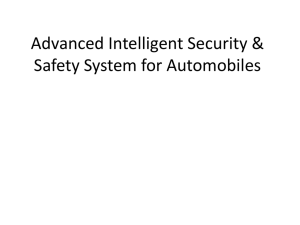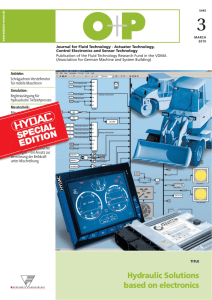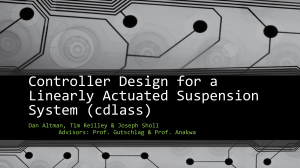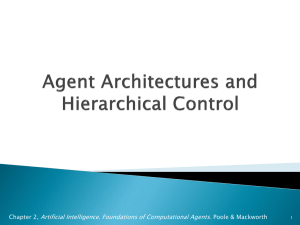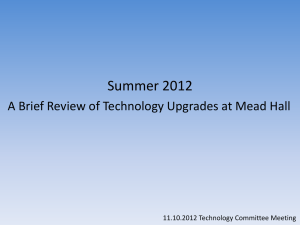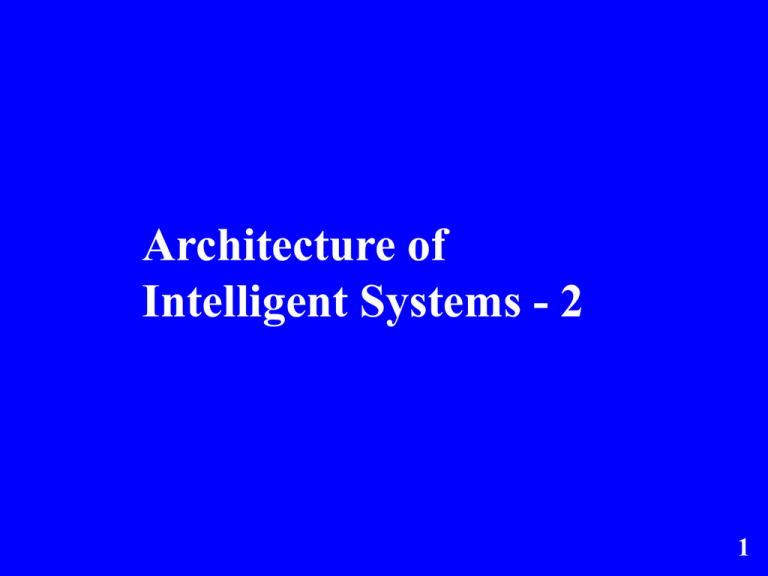
Architecture of
Intelligent Systems - 2
1
Plan
• Analysis of a Physical system with
simple control function
• Complex system and Abstraction
• Mapping of the physical system to the
Intelligent system
2
Sensor
Compa Refere
rator nce
Signal
Conditioning
Error
signal
Cold air
Control signal
Contr
oller
Correc
tor
Correction
signal
Actuator
Physical system Room with A/C
Controller
3
Sensor
Sensor
signal
Contro
ller
Cold air
Control
signal
Reference
value or
Control
parameters
Actuator
Physical system - A/C Room
4
Se
ns
or
Intelligent
system
Environment
Ac
tua
tor
Is IS a
controller?
5
•IS is some sort of controller (or at least a
controller and may be more)
Se
ns
or
Intelligent
Controller
system
Environment
Ac
tua
tor
6
•Can there be more than one sensor and
one actuator in a system?
•What other actions are needed in our IS
as a result of multiple sensors?
•Guess what type of sensors, actuators
and controls would you like to have in our
crazy car – 4 independent wheel drive
car!
•Would our simple controller be sufficient
for our car?
• There can be many sensors, actuators and
controllers
• Coordinate the actuators
• The information from multiple sensors is
to be analysed and control actions for
each actuator are to be identified, control
parameters and control actions are to be
generated.
• The model of the environment (world
model) is to be generated.
• Error handling information is to be
incorporated
Thus the system looks like
World model
Se
nso
rs
Controller
Sig
coor
nal
dina Controller
An
tor Controller
alys
er
Controller
? ? ?
Environment
Act
uat
ors
Crazy car
Sensors for indicating the direction and speed
of each wheel
User communication interface
Task identification and its decomposition
Control signal generation
Coordinate the control signals at the actuators
Model for the actions of the wheels
Sensors for the proximity and speed of other
cars and its own speed
World model for taking decisions regarding
collisions and collision avoidance
Knowledge base and expert advice for taking
decisions
How should we build our Intelligent system?
Do we need to pack all the features into a
single monolithic program or should we
build up a modular / layered product?
Remember all complex programs are
modular/layered - OS
How many layers?
Suggest three based on management model –
execution level, coordination level, executive
level. But could be as many as we like.
Execution
level
coordination
level
Top management
& Executive level
Sensors
Actua
tors
High level
management
Low level
management
Environment
Middle level
management
Low
Senso
rs
Physic
al
system
Middle
High
Data flow/ response
Commands
Actu
ators
Human interventions (in red)
Hu
ma
n
ope
rat
ors
Functional Architecture of Intelligent (control) system
Centralised Vs Distributed
Is it technology dependent?
Low level Or execution level control manager
Signal conditioning, sampling,
Sensor holding, buffering, multiplexing and
inform demultiplexing, queuing, scheduling
of data acquisition & actuators,
ation
data supply to controllers, control
parameter generation, error
detection and send error
information to appropriate units,
signals
to actua Algorithms in HW & SW
Execution of control
tors
Multiple sensor information,
multiple controllers
Multiple copies of HW & SW
Commn
with
middle
level
Human
interve
ntions
Middle level Or coordination level control manager
Coordination, Synchronisation,
Commn timing signals, Prioritisation and
with low sequencing, Monitoring sys health &
processes, decision making, capability
level
assessment, fault assessment and
analysis, system & environ model
generation & updating, learning, Task
analysis, Task decomposition,
planning for execution, Resource
management, algorithm development,
Knowledge bases, logic resolution,
Algorithm development, simulations
Interface between the low level &high
level, limited copies of HW & SW
Commn
with
high
level
Human
interve
ntions
High level Or organisational manager
Goal assessment and generation,
Commn Goal analysis, goal to task
conversion, Strategising,
with
middle planning to achieve goals,
consequence evaluation, decision
level
making, User I/F, feasibility analysis
and capability assessment, learning
knowledge bases, data mining,
Single copy
Human
interven
tions
and
commn
with
humans
P
h
y
s
i
c
a
l
s
Y
s
Sensors
M
u
x
Refe
rence
KB
Signal
Condi
tioning
Decision
making
unit (Int
control)
Load algos
Contro
llers
DB
Data
Switch
Commn
Sys state &
adaptive
parameters
Timer
Actua
tors
KB
Di
git Info buffer/
ise storage/anal
rs
De
Mux
Err
cor
Low level control details
Instructions, commands, algorithms
Fault info
analyser
KB
with
middle
level
Human
interve
ntions
From
data
switch
KB
Synchro
niser
Sched
uler
DSS
Sim/mod
Info
Assessor
Control
Implementation
supervisor
From
System Algos, commands,
State
instructions
model
Math model
Algo
KB Sim
develo
per
From
Fault
info
anal
Designer
Fault
Super
visor
Sim
KB
Commn.
with
Control
Exe
Manager cutive
(Task anal) Level
Algo Planner
Rep
osito Plan Plan
ry
selec gener
tor
ator
KB
Plan repository
Human
inter
vention
Fault
info
Stra
tegi
ser
Task
generator
/ goal
analyser
Comma
nds, &
tasks
Build
model
Goal
generator
KB and Data
warehouse
Capability/ feasi
bility assessor
System
model
Fault
info
Soln.
opti
miser
Command
Interpreter
Identification
of problems
& solutions
Commn.
from
Human
operator
Simulator
DSS
Decision on action
Info
gener
ator
Information
formatter
and
presenter
Info/
Messa
ges to
human
operator
End


